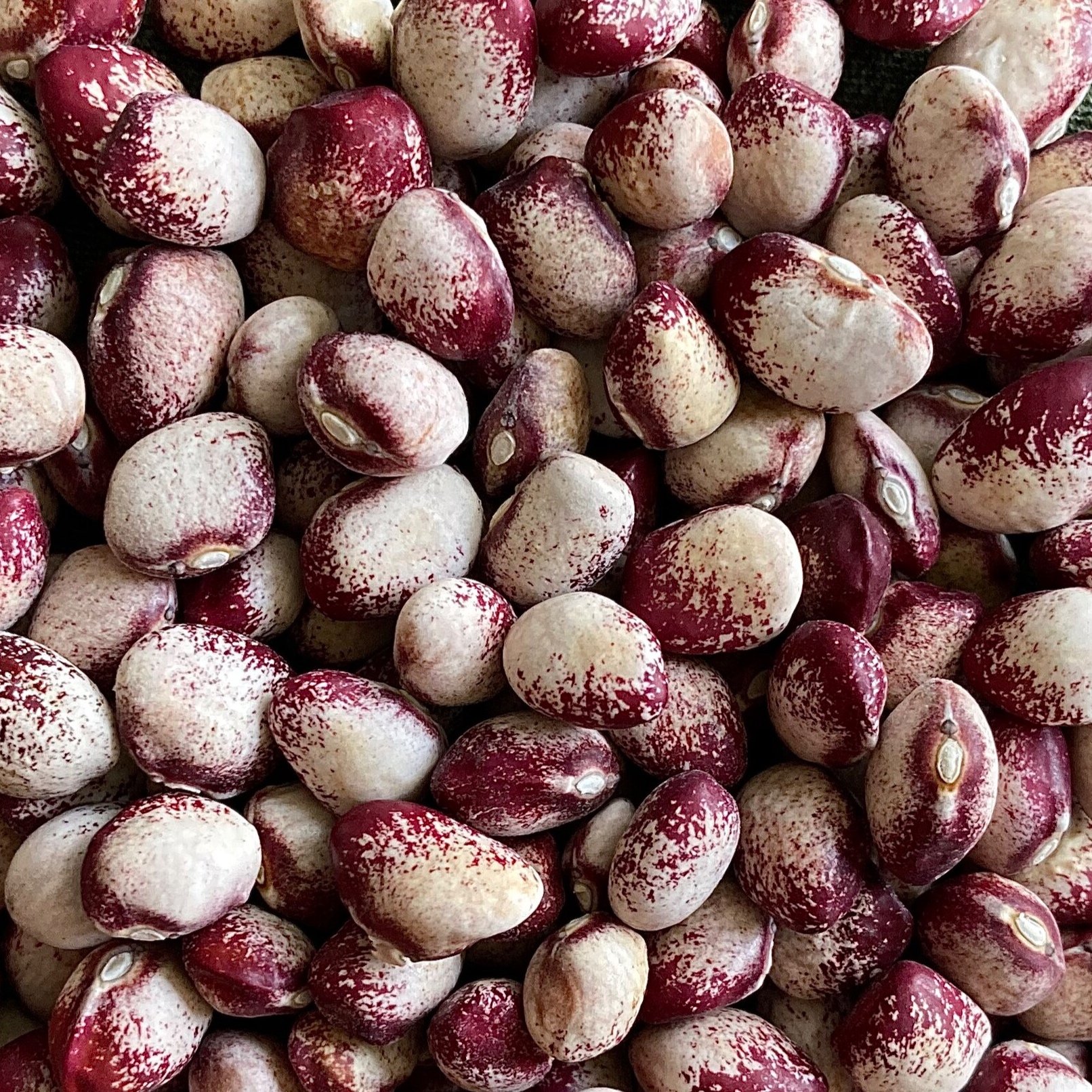 Image 1 of
Image 1 of


Bean, True Red Cranberry
Product Description: (Phaseolus vulgaris) The story of this plump, maroon-colored pole bean is one of outstanding endurance. As one of the first beans ever grown in the Northeast, True Red Cranberry could have been found climbing the stalks of other Abenaki “seven sisters” crops like Otto File or the Morrisville Sunflower many centuries ago.
This bean was mentioned in American Cookery (1796) — the first cookbook ever published in the United States — and Fearing Burr described it in 1863 as “one of the oldest and most familiar of garden-beans [which] has probably been longer and more generally cultivated in this country than any other variety.”
Despite its unequaled reign as New England’s most highly-regarded dry bean, True Red Cranberry had been all but forgotten by the mid-20th century. It was around this time that the famed bean collector, John Withee, embarked on an 11-year search for the nearly-extinct variety. His efforts ultimately ended with resounding success on one farmer’s field in Steep Falls, Maine. Pole habit. 25 seeds per packet.
Growing Information: Direct seed in full sun after all danger of frost has passed. Sow your beans 2.5 cm (1 inch) deep and 15 cm (6 inches) apart at the base of a trellis. Guide the vines up the trellis as they grow taller. For fresh string beans, harvest frequently to optimize yield. For dry beans, allow the entire plant to die back and dry until the pods are brown and brittle.
Make sure that your plants are receiving adequate airflow during this time to prevent excessive moisture and fungal growth. A small amount of spotting on the outside of drying pods is completely normal and will not affect the quality of the beans within. Once dry, harvest the pods and crack them open. Sort out any beans that are damaged or showing signs of rot then store your harvest in a cool, dry place until use. 100 days to maturity.
How To Save Bean Seeds
Allow the plant to dry out completely. Mature pods will be brown and brittle. Make sure that your plants are receiving adequate airflow to prevent excessive moisture and mold growth throughout the drying process. However, a small amount of mildew spotting on the outside of drying pods is completely normal and has no reason for concern. Once dry, harvest the seed pods and crack them open. Sort out any damaged, misshapen, or rotting beans. Continue the drying process if necessary then store them in a cool, dry place.
Product Description: (Phaseolus vulgaris) The story of this plump, maroon-colored pole bean is one of outstanding endurance. As one of the first beans ever grown in the Northeast, True Red Cranberry could have been found climbing the stalks of other Abenaki “seven sisters” crops like Otto File or the Morrisville Sunflower many centuries ago.
This bean was mentioned in American Cookery (1796) — the first cookbook ever published in the United States — and Fearing Burr described it in 1863 as “one of the oldest and most familiar of garden-beans [which] has probably been longer and more generally cultivated in this country than any other variety.”
Despite its unequaled reign as New England’s most highly-regarded dry bean, True Red Cranberry had been all but forgotten by the mid-20th century. It was around this time that the famed bean collector, John Withee, embarked on an 11-year search for the nearly-extinct variety. His efforts ultimately ended with resounding success on one farmer’s field in Steep Falls, Maine. Pole habit. 25 seeds per packet.
Growing Information: Direct seed in full sun after all danger of frost has passed. Sow your beans 2.5 cm (1 inch) deep and 15 cm (6 inches) apart at the base of a trellis. Guide the vines up the trellis as they grow taller. For fresh string beans, harvest frequently to optimize yield. For dry beans, allow the entire plant to die back and dry until the pods are brown and brittle.
Make sure that your plants are receiving adequate airflow during this time to prevent excessive moisture and fungal growth. A small amount of spotting on the outside of drying pods is completely normal and will not affect the quality of the beans within. Once dry, harvest the pods and crack them open. Sort out any beans that are damaged or showing signs of rot then store your harvest in a cool, dry place until use. 100 days to maturity.
How To Save Bean Seeds
Allow the plant to dry out completely. Mature pods will be brown and brittle. Make sure that your plants are receiving adequate airflow to prevent excessive moisture and mold growth throughout the drying process. However, a small amount of mildew spotting on the outside of drying pods is completely normal and has no reason for concern. Once dry, harvest the seed pods and crack them open. Sort out any damaged, misshapen, or rotting beans. Continue the drying process if necessary then store them in a cool, dry place.
Product Description: (Phaseolus vulgaris) The story of this plump, maroon-colored pole bean is one of outstanding endurance. As one of the first beans ever grown in the Northeast, True Red Cranberry could have been found climbing the stalks of other Abenaki “seven sisters” crops like Otto File or the Morrisville Sunflower many centuries ago.
This bean was mentioned in American Cookery (1796) — the first cookbook ever published in the United States — and Fearing Burr described it in 1863 as “one of the oldest and most familiar of garden-beans [which] has probably been longer and more generally cultivated in this country than any other variety.”
Despite its unequaled reign as New England’s most highly-regarded dry bean, True Red Cranberry had been all but forgotten by the mid-20th century. It was around this time that the famed bean collector, John Withee, embarked on an 11-year search for the nearly-extinct variety. His efforts ultimately ended with resounding success on one farmer’s field in Steep Falls, Maine. Pole habit. 25 seeds per packet.
Growing Information: Direct seed in full sun after all danger of frost has passed. Sow your beans 2.5 cm (1 inch) deep and 15 cm (6 inches) apart at the base of a trellis. Guide the vines up the trellis as they grow taller. For fresh string beans, harvest frequently to optimize yield. For dry beans, allow the entire plant to die back and dry until the pods are brown and brittle.
Make sure that your plants are receiving adequate airflow during this time to prevent excessive moisture and fungal growth. A small amount of spotting on the outside of drying pods is completely normal and will not affect the quality of the beans within. Once dry, harvest the pods and crack them open. Sort out any beans that are damaged or showing signs of rot then store your harvest in a cool, dry place until use. 100 days to maturity.
How To Save Bean Seeds
Allow the plant to dry out completely. Mature pods will be brown and brittle. Make sure that your plants are receiving adequate airflow to prevent excessive moisture and mold growth throughout the drying process. However, a small amount of mildew spotting on the outside of drying pods is completely normal and has no reason for concern. Once dry, harvest the seed pods and crack them open. Sort out any damaged, misshapen, or rotting beans. Continue the drying process if necessary then store them in a cool, dry place.





